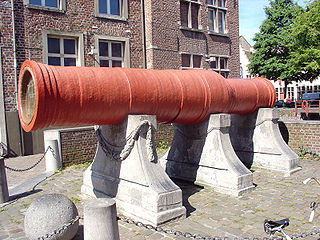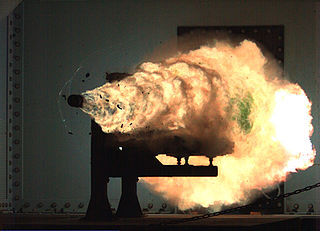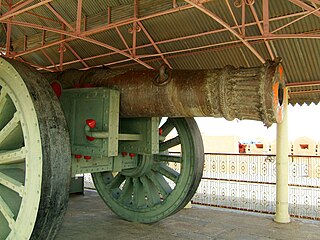 W
WThe formal definition of large-calibre artillery used by the United Nations Register of Conventional Arms (UNROCA) is "guns, howitzers, artillery pieces, combining the characteristics of a gun, howitzer, mortar, or multiple-launch rocket system, capable of engaging surface targets by delivering primarily indirect fire, with a calibre of 75 millimetres and above". This definition, shared by the Arms Trade Treaty and the Treaty on Conventional Armed Forces in Europe, is derived from a definition in United Nations General Assembly Resolution 46/36L, which set a threshold of 100mm. Several grammatical changes were made to that latter in 1992 and the threshold was lowered in 2003 to yield the current definition, as endorsed by UN General Assembly Resolution 58/54.
 W
WThe Basilic, or The Ottoman Cannon was a very large-calibre cannon designed by Urban, a cannon engineer, Saruca Usta and architect Muslihiddin Usta at a time when cannons were still new. It was horribly inaccurate, but when it hit, it caused massive damage to Constantinople's walls. Additionally, due to the material the cannon was constructed of, and the intense heat created by the charge, the cannon had to be cooled with olive oil between shots to prevent cracking. The heat also prevented the cannon from being fired more than three times per day. Ultimately, it lasted all of six weeks before becoming non-functional.Length: ~24 feet Diameter: 2.5 feet Cannonball: 600 lb Range: ~1 mile
 W
WThe Bibi Mariam Cannon is a large early modern artillery piece on display on the grounds of the Osmani Udyan in Dhaka, Bangladesh. The cannon dates from the 17th century.
 W
WThe bombard is a type of cannon or mortar which was used throughout the Middle Ages and the early modern period. Bombards were mainly large calibre, muzzle-loading artillery pieces used during sieges to shoot round stone projectiles at the walls of enemy fortifications, enabling troops to break in. Most bombards were made of iron and used gunpowder to launch the projectiles. There are many examples of bombards, including Mons Meg, the Dardanelles Gun, and the handheld bombard.
 W
WThe Dover Strait coastal guns were British and German long-range coastal artillery pieces, on the English Channel coasts of Kent, England and the Pas-de-Calais, occupied France. The Strait of Dover is the narrowest channel between England and continental Europe. During the Second World War, both sides used their guns to bombard shipping in the Channel as well as coastal towns and military installations.
 W
WThe Dulle Griet is a medieval large-calibre gun founded in Gent (Ghent).
 W
WThe Electro-Magnetic Laboratory Rail Gun is a 32-megajoule electro-magnetic laboratory rail gun being evaluated by the US Office of Naval Research (ONR) Naval Air Warfare and Weapons Department. The US Navy is pursuing development of the launcher system through two industry teams -- General Atomics and BAE Systems - to reduce risk in the program and to foster innovation in next-generation shipboard weapons. The same amount of energy is released by the detonation of 4.8 kg (11 lb) of C4.
 W
WThe Faule Grete was a medieval large-calibre cannon of the Teutonic Order. The bronze bombard was cast in 1409 in the cannon foundry of the Marienburg by the gunfounder Heynrich Dumechen. According to the account books of the order, the construction costs amounted to 278.5 Mark, a sum equivalent to ca. 1160 oxen.
 W
WThe Faule Mette or Faule Metze was a medieval large-calibre cannon of the city of Brunswick, Germany.
 W
WThe Griffin cannon, also called Vogel Greif,, is one of the largest cannons from the 16th century. Since 1984, it has been in display in the Ehrenbreitstein Fortress in Koblenz. The possession of the cannon moved several times between Germany and France and became a symbol of the Franco-German reconciliation.
 W
WJahan Kosha Cannon literally means the Destroyer of the World. It is placed in the Topekhana a quarter of mile to the south east of the Katra Mosque, in the town of Murshidabad, West Bengal, India. Topekhana was the Nawab's Artillery Park and the entrance gate of the old capital of Bengal, Bihar and Orissa, the city of Jahangir Nagar. It is protected on the east by the Gobra Nala, locally known as the Katra Jheel. Here, the Jahan Kosha Cannon is laid to rest. Before being placed at its current location, it rested on a carriage with wheels and was surrounded by the roots of a Peepal tree. The growth of the tree roots gradually lifted the gun four feet above the ground. The wheels of the gun carriage have disappeared, but the iron-work of the carriage and the trunions are still visible. The cannon is made of ashtadhatu or 8 metals, namely silver, gold, lead, copper, zinc, tin, iron and mercury.
 W
WThe Jaivana cannon is a large 18th-century weapon located in Jaigarh Fort, Rajasthan, India. at the time of its manufacture in 1720, it was the world's largest cannon on wheels of the Early Modern Era.
 W
WThe list of cannon by caliber contains all types of cannon through the ages listed in decreasing caliber size. For the purpose of this list, the development of large-calibre artillery can be divided into three periods, based on the kind of projectiles used, due to their dissimilar characteristics, and being practically incommensurable in terms of their bore size:Stone balls: Cannon of extraordinary bore, which fired stone balls, were first introduced at the turn of the 14th to 15th century in Western Europe. Following a logic of increasing performance through size, they had evolved from small handguns to giant wrought-iron or cast-bronze bombards within a span of just several decades. Iron balls and shot: By the 16th century, however, a general switch from stone balls to smaller, but much more effective iron projectiles was in full swing. This and the parallel tendency towards standardized, rapid-firing cannon made the enormously costly and logistically demanding giant guns soon obsolete in the European theatre. Explosive shells: In the Industrial Age, artillery was again revolutionized by the introduction of explosive shells, beginning with the Paixhans guns. Breakthroughs in metallurgy and modes of production were followed up by new experimentation with super-sized caliber weapons, culminating in the steel colossi of the two World Wars. In the post-war era, the development of extremely overpowered artillery was gradually abandoned in favour of missile technology, while heavy guns are still demanded by various arms of the service.
 W
WNuclear artillery is a subset of limited-yield tactical nuclear weapons, in particular those weapons that are launched from the ground at battlefield targets. Nuclear artillery is commonly associated with shells delivered by a cannon, but in a technical sense short-range artillery rockets or tactical ballistic missiles are also included.
 W
WThe Parrott rifle was a type of muzzle-loading rifled artillery weapon used extensively in the American Civil War.
 W
WProject Babylon was a space gun project commissioned by then Iraqi president Saddam Hussein. It involved building a series of "superguns". The design was based on research from the 1960s Project HARP led by the Canadian artillery expert Gerald Bull. There were most likely four different devices in the program.
 W
WQueen Elizabeth's Pocket Pistol is a cannon built in 1544 in Utrecht by Jan Tolhuys, before Elizabeth I came to the throne. The gun was presented to Henry VIII by Maximiliaan van Egmond, Count of Buren and Stadtholder of Friesland as a gift for his young daughter Elizabeth.
 W
WThe Tiro de Diu is a 16th-century siege cannon, specifically a large-calibre basilisk, which saw action in the First Siege of Diu in 1538.